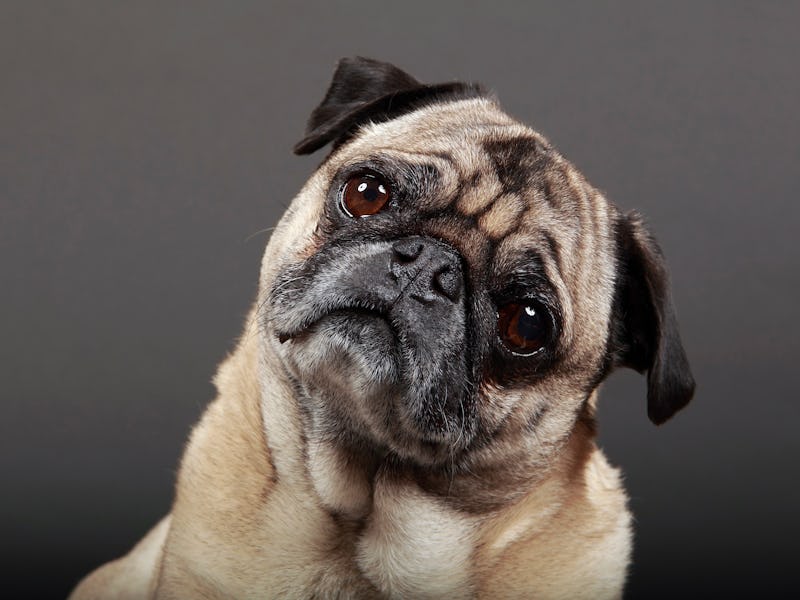What is my dog thinking? Science may finally have an answer
New research yields surprising insights into a dog's mind.

As much as we love our dogs, we still don’t fully understand what’s going on inside their minds. But some researchers are on the hunt to solve the mystery of canine cognition, starting with answering the most basic question: How do dogs think?
Research published last week in the journal Animal Cognition offers rare insight into how dogs’ minds form a representation of the world through their favorite objects: toys.
“If we can understand which senses dogs use while searching for a toy, this may reveal how they think about [that toy],” Shany Dror, lead author of the study and a Ph.D. student at the Ethology Department at the Eötvös Loránd University in Budapest, tells Inverse.
What’s new — The researchers conducted two experiments testing the abilities of typical dogs and Gifted Word Learner dogs — canines that can quickly learn the names of toys — to discriminate between familiar objects like toys in different circumstances.
Based on the ways the Gifted Word Learner dogs used their senses to seek out and find the toys, researchers concluded they formed “multisensory mental representations” of the toys. In essence: These dogs form a mental image of their toys using different senses like smell and vision.
“The findings of this study suggest that when the Gifted Word Learner dogs hear the name of a familiar toy it evokes in their mind a mental image that includes the different features of that toy, such as the way it looks and smells,” Dror says.
How do dogs perceive the world around them? Researchers are getting closer to answering that question.
Why it matters — If you’re still confused, Dror offers a simple comparison to the human mind.
“Let's say I am asking you to imagine a lemon. What would you imagine?” Dror asks.
You might form a picture of a yellow-ish fruit in your mind, or perhaps you recall the sour taste and crisp scent of the citrus fruit.
“For humans, often thinking of a lemon evokes a mental image that includes different senses. This study suggests that the same is true for dogs,” Dror explains.
It’s a pretty remarkable finding, offering new insight into the similarities between human and canine thinking. Previously, researchers knew Gifted Word Learner dogs could learn the names of their beloved toys rapidly, but it was harder for the researchers to pinpoint what the dogs were thinking when they heard the name of a familiar object.
But now, researchers have a better idea of how dogs form a mental representation of familiar objects, bringing us one step closer to understanding how Fido’s brain works.
“Examining the ways in which Gifted Word Learner dogs think about their named toys is fascinating because it gives us an opportunity to see how verbal labels may influence the ways other species think of objects,” Dror says.
But the study is no mere thought experiment — it could also help dog owners better comprehend how their own pets perceive the world around them.
“These findings can help dog owners better understand how their dogs think of their environment and the objects in it,” Dror concludes.
A figure from the study shows how researchers placed toys in a separate room. Dogs would have to find their toys in light and dark settings.
How they did it — In the first experiment in the study, researchers conducted two different experiments to see how the two groups of canines — three Gifted Word Learners and 10 typical dogs — distinguish between and recognize their toys in light and dark settings. In the second experiment in the study, researchers tested whether Gifted Word Learner Dogs could identify their toy based on its name — again, in both light and dark settings. In both experiments, the toys were placed in a separate room from the room where the owners and researchers were standing.
Both groups of dogs were able to discriminate between familiar objects, and all dogs sniffed longer in the dark because they could not readily see the toys. Without light, dogs had to use other senses to identify their toys, which they did successfully. Dror says this finding suggests that owners’ training sessions with their pets — in which dogs learn to recognize their toys — helped the dogs “encode” different features of the toy, such as its smell or appearance.
What’s next — In this study, researchers assessed how dogs discriminated between objects using multisensory representation. In future research, Dror hopes to tackle “the other side of the coin” and how typical and Gifted Word Learner dogs categorize objects.
“Understanding this may bring us a small step closer to understanding how verbal labels influence the internal mental processes of another species,” Dror says.
Think your dog is a Gifted Word Learner? The researchers are still looking for these genius pups to participate in future canine research. If your dog is especially adept at learning the names of toys, you can reach out to the study coordinators via this website. Your dog might just bring us one step closer to understanding the canine mind.